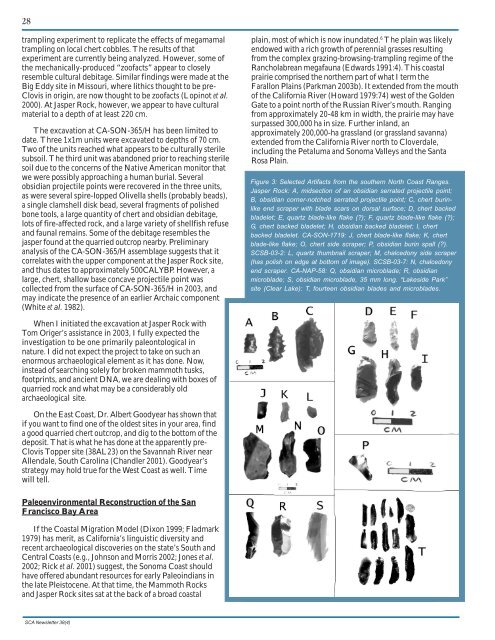Mammoth Rub Update - Society for California Archaeology
Mammoth Rub Update - Society for California Archaeology
Mammoth Rub Update - Society for California Archaeology
Create successful ePaper yourself
Turn your PDF publications into a flip-book with our unique Google optimized e-Paper software.
28<br />
trampling experiment to replicate the effects of megamamal<br />
trampling on local chert cobbles. The results of that<br />
experiment are currently being analyzed. However, some of<br />
the mechanically-produced “zoofacts” appear to closely<br />
resemble cultural debitage. Similar findings were made at the<br />
Big Eddy site in Missouri, where lithics thought to be pre-<br />
Clovis in origin, are now thought to be zoofacts (Lopinot et al.<br />
2000). At Jasper Rock, however, we appear to have cultural<br />
material to a depth of at least 220 cm.<br />
The excavation at CA-SON-365/H has been limited to<br />
date. Three 1x1m units were excavated to depths of 70 cm.<br />
Two of the units reached what appears to be culturally sterile<br />
subsoil. The third unit was abandoned prior to reaching sterile<br />
soil due to the concerns of the Native American monitor that<br />
we were possibly approaching a human burial. Several<br />
obsidian projectile points were recovered in the three units,<br />
as were several spire-lopped Olivella shells (probably beads),<br />
a single clamshell disk bead, several fragments of polished<br />
bone tools, a large quantity of chert and obsidian debitage,<br />
lots of fire-affected rock, and a large variety of shellfish refuse<br />
and faunal remains. Some of the debitage resembles the<br />
jasper found at the quarried outcrop nearby. Preliminary<br />
analysis of the CA-SON-365/H assemblage suggests that it<br />
correlates with the upper component at the Jasper Rock site,<br />
and thus dates to approximately 500CALYBP. However, a<br />
large, chert, shallow base concave projectile point was<br />
collected from the surface of CA-SON-365/H in 2003, and<br />
may indicate the presence of an earlier Archaic component<br />
(White et al. 1982).<br />
When I initiated the excavation at Jasper Rock with<br />
Tom Origer’s assistance in 2003, I fully expected the<br />
investigation to be one primarily paleontological in<br />
nature. I did not expect the project to take on such an<br />
enormous archaeological element as it has done. Now,<br />
instead of searching solely <strong>for</strong> broken mammoth tusks,<br />
footprints, and ancient DNA, we are dealing with boxes of<br />
quarried rock and what may be a considerably old<br />
archaeological site.<br />
On the East Coast, Dr. Albert Goodyear has shown that<br />
if you want to find one of the oldest sites in your area, find<br />
a good quarried chert outcrop, and dig to the bottom of the<br />
deposit. That is what he has done at the apparently pre-<br />
Clovis Topper site (38AL23) on the Savannah River near<br />
Allendale, South Carolina (Chandler 2001). Goodyear’s<br />
strategy may hold true <strong>for</strong> the West Coast as well. Time<br />
will tell.<br />
Paleoenvironmental Reconstruction of the San<br />
Francisco Bay Area<br />
If the Coastal Migration Model (Dixon 1999; Fladmark<br />
1979) has merit, as Cali<strong>for</strong>nia’s linguistic diversity and<br />
recent archaeological discoveries on the state’s South and<br />
Central Coasts (e.g., Johnson and Morris 2002; Jones et al.<br />
2002; Rick et al. 2001) suggest, the Sonoma Coast should<br />
have offered abundant resources <strong>for</strong> early Paleoindians in<br />
the late Pleistocene. At that time, the <strong>Mammoth</strong> Rocks<br />
and Jasper Rock sites sat at the back of a broad coastal<br />
SCA Newsletter 38(4)<br />
plain, most of which is now inundated. 6 The plain was likely<br />
endowed with a rich growth of perennial grasses resulting<br />
from the complex grazing-browsing-trampling regime of the<br />
Rancholabrean megafauna (Edwards 1991:4). This coastal<br />
prairie comprised the northern part of what I term the<br />
Farallon Plains (Parkman 2003b). It extended from the mouth<br />
of the Cali<strong>for</strong>nia River (Howard 1979:74) west of the Golden<br />
Gate to a point north of the Russian River’s mouth. Ranging<br />
from approximately 20-48 km in width, the prairie may have<br />
surpassed 300,000 ha in size. Further inland, an<br />
approximately 200,000-ha grassland (or grassland savanna)<br />
extended from the Cali<strong>for</strong>nia River north to Cloverdale,<br />
including the Petaluma and Sonoma Valleys and the Santa<br />
Rosa Plain.<br />
Figure 3: Selected Artifacts from the southern North Coast Ranges.<br />
Jasper Rock: A, midsection of an obsidian serrated projectile point;<br />
B, obsidian corner-notched serrated projectile point; C, chert burinlike<br />
end scraper with blade scars on dorsal surface; D, chert backed<br />
bladelet; E, quartz blade-like flake (?); F, quartz blade-like flake (?);<br />
G, chert backed bladelet; H, obsidian backed bladelet; I, chert<br />
backed bladelet. CA-SON-1719: J, chert blade-like flake; K, chert<br />
blade-like flake; O, chert side scraper; P, obsidian burin spall (?).<br />
SCSB-03-2: L, quartz thumbnail scraper; M, chalcedony side scraper<br />
(has polish on edge at bottom of image). SCSB-03-7: N, chalcedony<br />
end scraper. CA-NAP-58: Q, obsidian microblade; R, obsidian<br />
microblade; S, obsidian microblade, 35 mm long. “Lakeside Park”<br />
site (Clear Lake): T, fourteen obsidian blades and microblades.

















